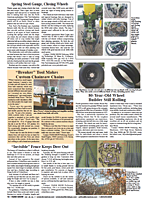You have reached your limit of 3 free stories. A story preview is shown instead.
To view more stories
(If your subscription is current,
click here to Login or Register.)
He Plants Corn In Rows Up To 120In. Wide
The trend is definitely toward narrower rows for corn and there are good reasons for that. But according to agronomist Leroy Deichman, going to ultra wide rows might be an even better idea.
"We don't have to raise corn in 30 in. or narrower rows. Solar radiation (sunlight) may well be our most overlooked agric
..........
You must sign in, subscribe or renew to see the page.

You must sign in, subscribe or renew to see the flip-book
He Plants Corn In Rows Up To 120In Wide CROPS Miscellaneous The trend is definitely toward narrower rows for corn and there are good reasons for that But according to agronomist Leroy Deichman going to ultra wide rows might be an even better idea We don t have to raise corn in 30 in or narrower rows Solar radiation sunlight may well be our most overlooked agricultural resource says the Gibson City Illinois research and consulting agronomist He has spent the past 10 years on a research project to determine whether corn planted in wider than normal rows converts more sunlight into grain than corn planted in narrower rows His research has looked at rows spaced as wide as 120 in although 60 and 72 in spacings look the best at this time Our basic idea is that planting in wider than normal rows allow plants to make use of more of the available sunlight In our wide rows very few of the bottom leaves quit functioning and die something that s a common sight in narrower rows he says Deichman likes to say that every row in his extra-wide row studies yields as well as an outside row in narrow rows And that may be true He has documented yields of as much as 228 bu per acre in 60-in wide rows That was in our best year he admits adding that the trick to wide rows is hybrid selection In 2000 he documented 60-in row yields of right at 200 bu per acre from a handful of different hybrids compared with a popular hybrid planted under identical conditions in 30 in rows that averaged 186 bu per acre In total he s looked at 200 hybrids Thirteen have made it through a second phase of testing meaning he can say with a great deal of certainty that they would do well in 60 in rows One problem he faces is that seed companies keep retiring older hybrids Three of the hybrids we started with and that did very well in 60 in rows are no longer produced he says Trials often include both single row and twin-row plantings We prefer twin-rows but we ve been trying to make this method more applicable to everyone The twin-rows might be a deterrent since you need a special planter set up he says Most of his data compares wide row to 30-in rows In most cases wide row yields are 100 to 110 percent of narrow row yields he says He s conducted population studies on four hybrids that suggest yields might be as good or better with lower populations for hybrids that display multi-ear tendencies He s also conducted fertilizer studies in which wide rows have received reduced nitrogen applications These show some real promise on a hybrid-specific basis he says I definitely think we should be fertilizing differently than we do for 30 in rows Banding the bulk of the nutrients near the row rather than broadcasting P and K seems to be the best way to fertilize wide rows he says The most obvious management problem with extra-wide rows is weed control Corn in wide rows doesn t completely shade over the row middles Deichman has also looked at producing low-growing crops like soybeans between the corn rows The idea of 60-in twin-row corn with a 4-ft strip of soybeans between the rows has some appeal in keeping down weed populations and increasing overall income per acre Deichman s work has been funded for the past five years by Maize Research Unlimited Inc Paxton Illinois a closely held Illinois corporation with the stated purpose of researching and developing unconventional methods of corn production Twenty-five of the 28 shareholders are farmers Deichman sits on the group s five-member board of directors Maize Research has applied for patents and copyrights to protect these discoveries The overall conclusion from these studies is that if you can provide light to all of the mature chloroplasts in all the leaves on a corn plant right up to physiological maturity you can select hybrids that will make full use of that extra light he says Another thing they ve learned is that their results are repeatable on a field from year to year but the hybrids and row spacing that work on one field may not work on anoth
To read the rest of this story, download this issue below or click
here to register with your account number.





